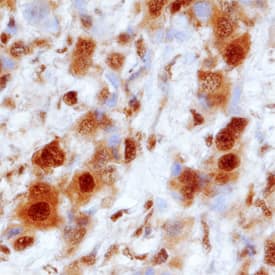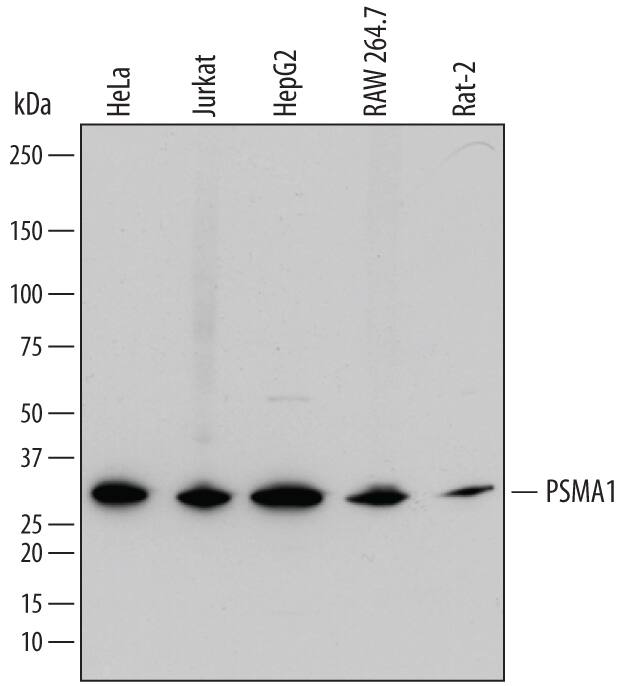Human/Mouse/Rat PSMA1 Antibody
R&D Systems, part of Bio-Techne | Catalog # AF7565

Key Product Details
Species Reactivity
Applications
Label
Antibody Source
Product Specifications
Immunogen
Gln16-His263
Accession # P25786
Specificity
Clonality
Host
Isotype
Scientific Data Images for Human/Mouse/Rat PSMA1 Antibody
Detection of Human, Mouse, and Rat PSMA1 by Western Blot.
Western blot shows lysates of HeLa human cervical epithelial carcinoma cell line, Jurkat human acute T cell leukemia cell line, HepG2 human hepatocellular carcinoma cell line, RAW 264.7 mouse monocyte/macrophage cell line, and Rat-2 rat embryonic fibroblast cell line. PVDF membrane was probed with 0.5 µg/mL of Sheep Anti-Human/Mouse/Rat PSMA1 Antigen Affinity-purified Polyclonal Antibody (Catalog # AF7565) followed by HRP-conjugated Anti-Sheep IgG Secondary Antibody (Catalog # HAF016). A specific band was detected for PSMA1 at approximately 30 kDa (as indicated). This experiment was conducted under reducing conditions and using Immunoblot Buffer Group 1.PSMA1 in Human Breast Cancer Tissue.
PSMA1 was detected in immersion fixed paraffin-embedded sections of human breast cancer tissue using Sheep Anti-Human/Mouse/Rat PSMA1 Antigen Affinity-purified Polyclonal Antibody (Catalog # AF7565) at 1.7 µg/mL overnight at 4 °C. Tissue was stained using the Anti-Sheep HRP-DAB Cell & Tissue Staining Kit (brown; Catalog # CTS019) and counterstained with hematoxylin (blue). Specific staining was localized to cytoplasm and nuclei. View our protocol for Chromogenic IHC Staining of Paraffin-embedded Tissue Sections.Applications for Human/Mouse/Rat PSMA1 Antibody
Immunohistochemistry
Sample: Immersion fixed paraffin-embedded sections of human breast cancer tissue
Western Blot
Sample: HeLa human cervical epithelial carcinoma cell line, Jurkat human acute T cell leukemia cell line, HepG2 human hepatocellular carcinoma cell line, RAW 264.7 mouse monocyte/macrophage cell line, and Rat‑2 rat embryonic fibroblast cell line
Formulation, Preparation, and Storage
Purification
Reconstitution
Formulation
Shipping
Stability & Storage
- 12 months from date of receipt, -20 to -70 °C as supplied.
- 1 month, 2 to 8 °C under sterile conditions after reconstitution.
- 6 months, -20 to -70 °C under sterile conditions after reconstitution.
Background: PSMA1
PSMA-1 (Proteosome subunit alpha type-1; also 30 kDa prosomal protein/PROS30, HC2, proteasome component C2/PSC2, PSMA-1/ alpha6, and NU) is a 30 kDa member of the peptidase T1A family of enzymes. It is widely expressed, and found in both cytoplasm and nucleus. Short-lived intracellular molecules (typically proteins) are enzymatically degraded by the 26S proteosome. This is a multisubunit 3D complex that is over 2000 kDa in size, and recognizes previously ubiquitinated proteins. The middle of this 26S complex is shaped like a barrel with four staves that run circumferentially rather than longitudinally. Each stave contains seven subunits, with beta-type subunits generating the two center staves, and alpha-type subunits comprising the outer, or flanking staves. The function of the barrel, also known as the 20S protease core "particle", is to enzymatically cleave substrates that enter its chamber. For proteins, this is done by beta-type subunits. The 26S complex also cleaves mRNA, and this is mediated by alpha-type subunits. PSMA-1/ alpha6 does not cleave mRNA, but it does positively regulate PSMA5/ alpha5 catalytic activity. Notably, PSMA-1 has also been reported to bind to LPS. Human PSMA-1 is 263 amino acids (aa) in length. It contains an acetylated Met at position #1, plus three utilized phosphorylation sites at Tyr6, Thr11, and Ser16. There are at least four potential isoform variants. Three utilize alternative start sites. One shows a start site at Met140, while a second and third initiates translation at sites 6 and 43 aa upstream of the standard site, respectively. A fourth isoform possess a 16 aa substitution for aa 115-263. Over aa 16-263, human PSMA-1 shares 98% aa sequence identity with mouse PSMA-1.
Long Name
Alternate Names
Gene Symbol
UniProt
Additional PSMA1 Products
Product Documents for Human/Mouse/Rat PSMA1 Antibody
Product Specific Notices for Human/Mouse/Rat PSMA1 Antibody
For research use only

